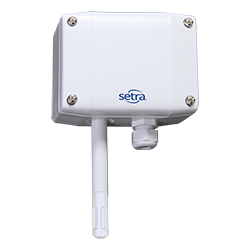ASHRAE recommends data center temperatures in the range of 64.4 to 80.6 F and humidity at 60 percent. Therefore, controlling temperature and humidity in data centers is vital for protecting equipment and ensuring efficiency. This blog introduces Setra Systems' SRH series sensors, which provide precise environmental monitoring to boost reliability, lower energy costs, and promote sustainability.

Monitoring and controlling temperature and relative humidity in a data center is essential for optimal equipment performance and longevity. Proper temperature management prevents overheating, which can lead to hardware failures and degrade components faster. It also improves PUE (Power Usage Efficiency), lowering operational costs and supporting sustainability goals.
 Humidity control is equally crucial. Low humidity increases the risk of static discharge, which can damage sensitive components, while high humidity can cause condensation and corrosion, leading to electrical issues. Maintaining appropriate humidity levels prevents these problems.
Humidity control is equally crucial. Low humidity increases the risk of static discharge, which can damage sensitive components, while high humidity can cause condensation and corrosion, leading to electrical issues. Maintaining appropriate humidity levels prevents these problems.
|
Model SRH 200 |
Model SRH Wall |
Model SRH - Outdoor Air |
Model SRH - Duct |
Environmental monitoring systems, including Setra's SRH series temperature and humidity sensors, provide real-time data on temperature and humidity levels. These sensors integrate with cooling systems like CRAC and CRAH units, chilled water systems, and airflow management techniques to ensure precise control.
Setra's sensors enable efficient management of cooling and humidity control systems, enhancing energy efficiency and reducing operational costs. By leveraging Setra’s advanced technologies, data centers can achieve optimal performance, sustainability, and efficiency.









